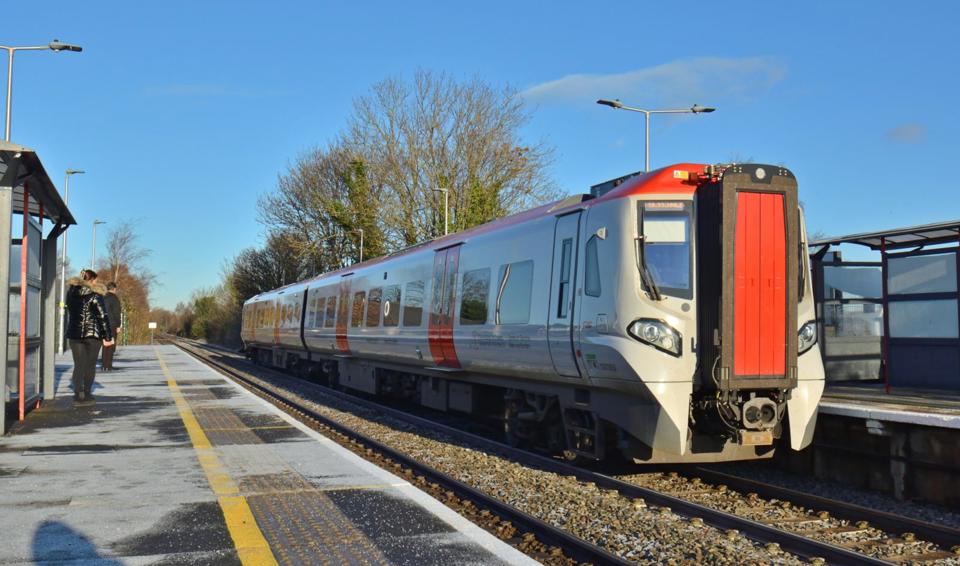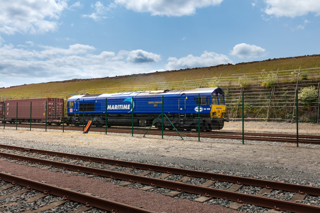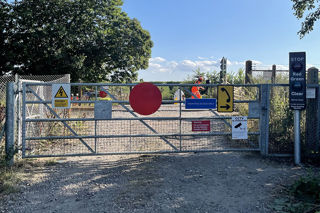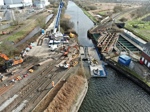Chris Howe reports on problems that have been affecting services between Wrexham and Bidston.
At the beginning of 2023, the service provided by Transport for Wales on the Wrexham-Bidston line could at best have been described as mediocre, and at one stage non-existent.
Chris Howe reports on problems that have been affecting services between Wrexham and Bidston.
At the beginning of 2023, the service provided by Transport for Wales on the Wrexham-Bidston line could at best have been described as mediocre, and at one stage non-existent.
There was no single cause at fault, rather a catalogue of problems which culminated in the cancellation of all services on the Borderlands line in March 2023.
The service level had deteriorated to such an extent that in March 2023, the Wrexham-Bidston Rail Users Association (WBRUA) took the unprecedented step of releasing an open letter calling for an immediate independent review into what it saw as failings at Transport for Wales. The letter highlighted the issues that have blighted passengers who rely on the Borderlands Line to get to work, school or college.
There was no service at all during March 2023, due to week-long engineering works, followed by the crisis which resulted in the withdrawal of all of TfW’s 27 Class 175s.
Class 150s, which at the time operated on the Borderlands Line, were moved over to work on long-distance routes, leaving passengers to face significantly longer journeys on replacement bus services.
In order to restore the service, TfW attempted to introduce the long-delayed Class 230s on the route. They should have entered service in 2019, but owing to late delivery, technical problems, and Vivarail entering into administration in November 2022, the first unit did not enter traffic until April 2023.
Upon entering service, the hybrid diesel-battery-electric units were beset with technical problems, and they remained unreliable throughout much of 2023.
What’s more, the units, which were supposed to be able to accelerate much more quickly than Class 150s, failed to reliably achieve the end-to-end journey time from Wrexham Central to Bidston of 58 minutes. This led to cumulative delays throughout the day, which in turn led to services skipping stops or being cancelled at short notice.
During the summer of 2023, the reliability of the units did improve somewhat, although there were still unresolved timing issues.
On paper, the Class 230s should have performed much better than the Class 150s, due to the use of electric traction equipment, which took power from batteries rather than directly from the Gensets.
However, in practice, it appeared as if the units were difficult to drive to their full potential, with short platforms and unusual braking characteristics meaning that they were perhaps being driven more cautiously in service than during testing.
The doors on the ex-D78 Stock units were also infamously slow to open and close, which led to extended dwell times at stations.
The additional time at each station may have only amounted to a few seconds, but with 12 stops between Bidston and Wrexham Central the time penalty quickly accumulated.
In June 2023, TfW acknowledged the poor level of service on the route and promised to improve reliability by instituting a ‘five-point plan’, which included appointing a dedicated route officer tasked with identifying the causes of the timing and reliability issues.
Soon after the units entered service, it became apparent that there were issues with cooling the batteries, which affected their performance.
A temporary solution was put in place, whereby the units were swapped during the day. Initially, only one out of five Class 230s was in service at any one time, with the remaining four either used as spare, being repaired, or having gensets overhauled.
The Class 230s are maintained at Birkenhead North EMUD, where the units are also stabled. In addition, TfW invested in a dedicated workshop to overhaul the gensets, which have to be swapped and serviced regularly.
The gensets, of which there are four per unit, comprise 3.2-litre Ford Duratorq engines, mated to generators, which can send power to the batteries and traction motors directly.
As the engines were not designed to be slung underneath rail vehicles, there were reportedly problems with the filters clogging up with pollen, which meant they had to be regularly swapped.
With these issues identified, TfW has been working on permanent solutions, and at the beginning of October 2024 a TfW spokesperson said that testing of the modifications was under way.
TfW 230006, the first set to receive the modifications, entered service on October 18, although leaf fall-related delays meant it was difficult to measure the unit's overall performance. In addition, 230006 continued to be swapped mid-shift as before.
With only one Class 230 available for service at a time, TfW had to supplement other diagrams with Class 197s, which started operating on the line in November 2023.
However, there were concerns that Class 197s would not be able to achieve the required end-to-end journey time, especially during the winter.
This is because a 0-40mph performance is crucial on the Wrexham-Bidston line, owing to the frequent station stops, and while the ‘197s’ are significantly more powerful than Class 150s, they are not geared to operate local services.
Initially, it appeared as if the Class 197s were struggling to keep to time, although their entry into service at the beginning of winter did mean it was difficult to establish for certain if they could reliably achieve an end-to-end journey time of 58 minutes.
The failure of the new units to reliably keep to time ultimately led to TfW (with input from the WBRUA) devising a solution that would enhance the service and improve reliability.
The solution was to increase the frequency from hourly to every 45 minutes, which somewhat counterintuitively also aided reliability.
This is because it allowed TfW to operate three diagrams instead of two, and in so doing allowed the journey time to be increased from around 58 minutes to 64 minutes, thus providing time for recovery.
This enhancement wasn’t as beneficial as the promised half-hourly service that was supposed to have been introduced by December 2021.
Nevertheless, it was imperative that reliability was improved so that workers and students could once again rely on the line, which had been used heavily by students prior to 2023.
The new timetable does appear to have restored passenger confidence, with TfW reporting that a total of 197,047 journeys had been made between January and July 2024, compared with 138,743 over the corresponding period in 2023.
TfW also reported that reliability had improved by 27% since 2023, with 87.7% of trains arriving within three minutes in July 2024, compared with just 46.4% in July 2023.
The modifications do seem to have improved reliability, and two Class 230s began to be diagrammed in March, which released a Class 197 for other duties.
The units are now also mostly able to work for the whole day, rather than being swapped in the afternoon.
TfW is now seeking to operate all three diagrams with Class 230s, which would release the remaining Class 197.
Whether the modifications are successful in the long term or not, TfW should still seek to find a medium-term solution allowing for the introduction of a reliable half-hourly service.
While there has been talk about introducing battery-powered Class 777s on the route, operating into Liverpool, this proposal is a long-term aspiration and will require significant funding - estimated by a North Wales Transport Commission report at between £255 million and £377m.
However, poor reliability, timekeeping and availability of the units are not the only barriers to the introduction of a half-hourly service.
In 2022, Network Rail declared the line to be “congested infrastructure”, which triggered a 12-month window to produce an enhancement plan.
NR initially deemed the introduction of a half-hourly service to be incompatible with the proposed additional freight workings in and out of Padeswood Cement Works, even with the additional service-skipping stop as proposed by TfW.
In a report published by Network Rail in January 2023, it was recommended that an additional block section be installed on the route and a new entrance to Padeswood be constructed.
This would remove the conflict between passenger and freight services, with the current freight service from Cotton Hill to Penyffordd Cement Sidings blocking the Down line for 40 minutes. This is due to the need for the cement train to stop on the Down line and reverse into the siding. Then, on the return, the train must head north on the Down line to Dee Marsh, where the service reverses to head south to Cotton Hill via Wrexham General.
A temporary workaround was suggested by the WBRUA, and subsequently put to TfW and Network Rail by Growth Track 360. This would have seen a two-hour gap in the half-hourly service during the day, to provide a path for the freight service to and from Padeswood.
NR did agree to the compromise, but the later failure of the Class 230s to reliably keep to time, as well as unit availability, meant the half-hourly service was deemed unworkable.
So, it would seem, for the time being at least, that the half-hourly service is unworkable, and that the 45-minute frequency will be retained for the foreseeable future.
But if passenger numbers continue to recover, then the Department for Transport may yet see fit to provide the funding needed for the proposed upgrades. Unfortunately, two previous Levelling Up fund bids were rejected, despite the last attempt to secure funding only seeking a modest £30m investment.
Groups such as GT360 and the WBRUA will undoubtedly hope that a solution can be found in the interim, to increase the frequency to two trains per hour, which will provide significant benefits for passengers by improving connectivity with Merseyrail services at Bidston.
In addition, the half-hourly service would work in concert with the planned 2tph service calling at Shotton low level (from 2026) to improve connectivity between the Borderlands line and North Wales Main Line.
While the 45-minute frequency has improved the fortunes of the line, it is felt that only a half-hourly clockface timetable will provide the connectivity needed to drive a significant shift from road, and lead to an increase in passenger figures - an increase which has the potential to encourage further investment which would one day allow trains to travel directly from Wrexham into Liverpool.
Login to continue reading
Or register with RAIL to keep up-to-date with the latest news, insight and opinion.



















Login to comment
Comments
No comments have been made yet.